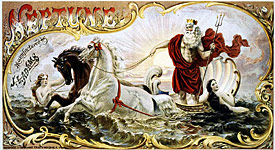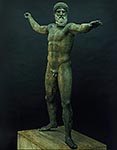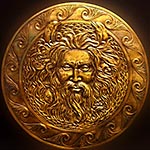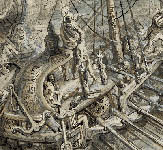ROME
020 Roman empire -Neptune
 "Neptune was the name that ancient Romans gave to the Greek god of the sea and earthquakes, Poseidon. He was the brother of Jupiter (Zeus) and of Pluto (Hades). After the defeat of their father Saturn (Cronos), the three brothers divided the world in three parts to be ruled by one of the three brothers. Jupiter took the sky, Neptune the sea and Pluto the underworld." www.windows2universe.org
"Neptune was the name that ancient Romans gave to the Greek god of the sea and earthquakes, Poseidon. He was the brother of Jupiter (Zeus) and of Pluto (Hades). After the defeat of their father Saturn (Cronos), the three brothers divided the world in three parts to be ruled by one of the three brothers. Jupiter took the sky, Neptune the sea and Pluto the underworld." www.windows2universe.orgNeptune is the god of the sea in Roman mythology, a brother of Jupiter and Pluto. He is analogous but not identical to the god Poseidon of Greek mythology. The Roman conception of Neptune owed a great deal to the Etruscan god Nethuns. Originally he was an Italic god paired with Salacia, possibly the goddess of the salt water. At an early date (399 BC) he was identified with Poseidon, when the Sibylline books ordered a lectisternium in his honour (Livy v. 13)". "In earlier times it was the god Portunes or Fortunus who was thanked for naval victories, but Neptune supplanted him in this role by at least the first century BC, when Sextus Pompeius called himself "son of Neptune."
"Neptune was associated as well with fresh water, as opposed to Oceanus, god of the world-ocean."
"Like Poseidon, Neptune was also worshipped by the Romans as a god of horses, under the name Neptune Equester, patron of horse-racing."
"Neptune was also considered the legendary progenitor god of a Latin stock, the Faliscans - ancient Italian people - who called themselves Neptunia proles. In this respect he was the equivalent of Mars, Janus, Saturn and even Jupiter among Latin tribes."
www.crystalinks.com
©: Tobacco product art 1860-1870 (Wikimedia commons)
tags: #Neptune
021 Roman empire -'Naval battle between Romans'
'The naumaquia' (Naval battle between Romans). Oil on canvas, 125.6 x 200.5 cm. This work was presented at the National Society of Fine Arts in Paris, 1894. He received the gold medal at the International Exposition in Atlanta in 1895. Painter: Ulpiano CHECAThe naumachia (in Latin naumachia, from the Ancient Greek naumachuìa, literally "naval combat") in the Ancient Roman world referred to both the staging of naval battles as mass entertainment and the basin (or more broadly, the complex) in which this took place. Read more: us.wow.com
©: Wikimedia
tags: #naumaquia; #Checa
ref. # 021a Roman empire -Poseidon
 "Poseidon was the Greek god of the sea and earthquakes. Poseidon was depicted as a bearded man with long hair, holding a trident and accompanied by dolphins and fish. He had the reputation for having a very bad temper. The symbol of Poseidon's power was the three pronged spear known as the trident.
"Poseidon was the Greek god of the sea and earthquakes. Poseidon was depicted as a bearded man with long hair, holding a trident and accompanied by dolphins and fish. He had the reputation for having a very bad temper. The symbol of Poseidon's power was the three pronged spear known as the trident.The storms and earthquakes were a reflection of his furious rage. When he was angry, he split mountains and threw them into the sea to make islands. Poseidon was the brother of Zeus and Hades. He married Amphitrite who was one of his attendants, the Nereids. The Greek god Poseidon was known to the Romans with the name of Neptune."
text: www.windows2universe.org
Poseidon (Roman equivalent is Neptune) is one of the twelve Olympian deities of the pantheon in Greek mythology, brother of Zeus and Hades (Pluto). His main domain is the ocean, and he is called the 'God of the Sea'. Additionally, he is referred to as 'Earth-Shaker' due to his role in causing earthquakes, and has been called the "tamer of horses". He is usually depicted as an older male with curly hair and beard."
"Poseidon, like his brothers and sisters, lived the first years of his life in the dark belly of his father Cronus. By the time their brother, Zeus, with the magical potion of Metis, managed to get them out of the peculiar prison."
There are also other myths about the birth of Poseidon. Thus, the ancient poets tell that Rhea in the case of Poseidon managed to fool her husband. Rather than giving him to swallow the divine infant, she gave him, wrapped in swaddling clothes, a newborn horse. Then, in order to conceal the baby's crying from Cronus, Rhea put it to grow among a flock of sheep."
"The nymph Arne took over the growing up of Poseidon. Someday Cronus went through there, because he thought he heard the crying of a baby, and asked Arne if there was a baby nearby. She replied to him with cleverness, that how a baby could be born by sheep or by her that was single. Cronus was fooled and ashamed by her answer and left."
www.greek-mythology-pantheon.com
©: Greek bronze sculpture depicting the god Poseidon. 'Poseidon Soter at Artemisium' (c. 575 B.C.). The statue was found in the Aegean Sea in 1926. Image courtesy of the National Archaelogical Museum at Athens, Greece.
tags: #Poseidon
ref. # 021b Roman empire -Oceanus
 "Oceanus refers to the ocean which the Greeks and Roman thought of as life circling the world 005. Strictly speaking, it was the ocean-stream at the middle of earth in which floated the habitable hemisphere. In Greek mythology this world-ocean was personified as a Titan, a son of Uranus and Gaia. In ancient Greek beliefs this Titan is often described as having the upper body of a muscular man with a long beard and the lower body of a serpent." Oceanus Trevi fountain, Rome
"Oceanus refers to the ocean which the Greeks and Roman thought of as life circling the world 005. Strictly speaking, it was the ocean-stream at the middle of earth in which floated the habitable hemisphere. In Greek mythology this world-ocean was personified as a Titan, a son of Uranus and Gaia. In ancient Greek beliefs this Titan is often described as having the upper body of a muscular man with a long beard and the lower body of a serpent." Oceanus Trevi fountain, Rome"Oceanus was a divine figure in classical antiquity, believed by the ancient Greeks and Romans to be the divine personification of the sea, an enormous river encircling the world." Wikipedia
"Oceanus was an ancient Greek god. According to one version, he was born by the union of the primal gods Chaos and Gaea, sanctified by god Eros. Another version has it that he was one of the twelve Titans, thus a son of Gaea and Uranus.
Oceanus was married to his sister, Tethys, with whom he had numerous children, called Oceanids. These were the lesser gods and goddesses of the rivers, the sea, and the springs. In fact, Oceanus and Tethys were so fertile that the overproduction of the aqueous elements of nature would cause floods; so, they divorced to stop this from happening. The couple was not involved in the Titanomachy against Zeus, so the latter let them continue their reign in their watery kingdom.
In ancient Greek art, Oceanus was depicted having bull horns and the tail of a serpentine fish instead of legs. He was later considered as a simple sea god or the personification of the sea. Oceanus is also called Ocean, Oceanos. www.greekmythology.com
©: picture hadesrocks.blogspot.nl
tags: #oceanus
,
 'The Roman Fleet Victorious over the Carthaginians at the Battle of Cape Ecnomus' (detail)
'The Roman Fleet Victorious over the Carthaginians at the Battle of Cape Ecnomus' (detail)
Gabriel Jacques de SAINT-AUBIN (French, 1724 - 1780)<, >, Drawing: Watercolor, gouache, pen and India and brown ink over black chalk. France (about 1763)
Source: J. Paul Getty Museum. Object Number: 2006.23 Dimensions: 21.5x39.6 cm (8 7/16 x 15 9/16 in.)
"The sea teems with a seemingly endless fleet of warships; a vast battle looms, ships crowd closer and closer to one another. Rows of oars froth up the sea, the frenzied water foreshadowing the impending combat. Standing at opposite ends of the two central ships are the leaders of warring factions. On one deck is the stoic Roman general Regulus, commanding his followers as they attempt to board an enemy ship. Opposing Regulus is the Carthaginian leader Hamilcar Barca, father of the famed general Hannibal. In fanciful reference to Hannibal, the Carthaginian prows are elephant heads armed with imposing ramming tusks.
Gabriel Jacques de SAINT-AUBIN meticulously described every detail of the foreground ships. He first drew the composition in black chalk and then used pen and ink to further articulate details of the ships, such as their masts and riggings, and the myriad figures. Using a limited palette of deftly applied watercolor--gray, brown, and blue--Saint-Aubin sensitively colored the sea and sky.
The first Punic War (264-241 BC) was a conflict largely fought at sea. Involving ove, three hundred vessels, the battle depicted here was one of the largest navel battles in history. The smaller Roman fleet defeated the Carthaginian by dividing their forces into four squadrons and waging four separate battles.
This drawing is one of a series of illustrations Saint-Aubin made in the 1760s for an ambitious history of Rome. Engravings after drawings as well as maps were to accompany this multi-volume series which was never completed. In 1789, twenty-nine engraved plates from Saint-Aubin's drawings illustrated a more modest Roman history."
©: PD - J. Paul Getty Museum
tags: #battle of cape ecnomus, #saint-auban, #j. Paul Getty museum, #punic war
140 -Roman Fleet Victorious over the Carthaginians
 'The Roman Fleet Victorious over the Carthaginians at the Battle of Cape Ecnomus' (detail)
'The Roman Fleet Victorious over the Carthaginians at the Battle of Cape Ecnomus' (detail)Gabriel Jacques de SAINT-AUBIN (French, 1724 - 1780)<, >, Drawing: Watercolor, gouache, pen and India and brown ink over black chalk. France (about 1763)
Source: J. Paul Getty Museum. Object Number: 2006.23 Dimensions: 21.5x39.6 cm (8 7/16 x 15 9/16 in.)
"The sea teems with a seemingly endless fleet of warships; a vast battle looms, ships crowd closer and closer to one another. Rows of oars froth up the sea, the frenzied water foreshadowing the impending combat. Standing at opposite ends of the two central ships are the leaders of warring factions. On one deck is the stoic Roman general Regulus, commanding his followers as they attempt to board an enemy ship. Opposing Regulus is the Carthaginian leader Hamilcar Barca, father of the famed general Hannibal. In fanciful reference to Hannibal, the Carthaginian prows are elephant heads armed with imposing ramming tusks.
Gabriel Jacques de SAINT-AUBIN meticulously described every detail of the foreground ships. He first drew the composition in black chalk and then used pen and ink to further articulate details of the ships, such as their masts and riggings, and the myriad figures. Using a limited palette of deftly applied watercolor--gray, brown, and blue--Saint-Aubin sensitively colored the sea and sky.
The first Punic War (264-241 BC) was a conflict largely fought at sea. Involving ove, three hundred vessels, the battle depicted here was one of the largest navel battles in history. The smaller Roman fleet defeated the Carthaginian by dividing their forces into four squadrons and waging four separate battles.
This drawing is one of a series of illustrations Saint-Aubin made in the 1760s for an ambitious history of Rome. Engravings after drawings as well as maps were to accompany this multi-volume series which was never completed. In 1789, twenty-nine engraved plates from Saint-Aubin's drawings illustrated a more modest Roman history."
©: PD - J. Paul Getty Museum
tags: #battle of cape ecnomus, #saint-auban, #j. Paul Getty museum, #punic war

